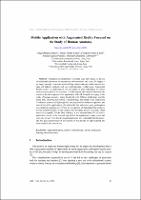| dc.contributor.author | Basurco-Reyes, Diego | |
| dc.contributor.author | Nuñez-Lopez, Arturo | |
| dc.contributor.author | Sierra-Liñan, Fernando | |
| dc.contributor.author | Zapata-Paulini, Joselyn | |
| dc.contributor.author | Cabanillas-Carbonell, Michael | |
| dc.date.accessioned | 2023-08-01T22:25:12Z | |
| dc.date.available | 2023-08-01T22:25:12Z | |
| dc.date.issued | 2022-12-20 | |
| dc.identifier.uri | https://hdl.handle.net/20.500.13067/2528 | |
| dc.description.abstract | Education in current times has taken leaps and bounds, so the use of traditional classrooms in conjunction with textbooks and static 2D images is no longer enough, even more so in the teaching of human anatomy, which requires images, didactic methods, and easy understanding. In that sense, Augmented Reality (AR) is a technological tool that takes on great importance in various areas and education is no exception. For this reason, this research describes the results of the development of an application with AR focused on helping in the study of human anatomy, being developed with ARCore technology and the Unity IDE, following the Mobile-D methodology. The results were analyzed in 3 indicators (amount of light required, time required for surface recognition, and ease of use of the application), of which in the first indicator a good performance was obtained requiring only 30 lux for recognition of illuminated flat surfaces; for the second indicator, it was obtained that the delay time is 3 seconds, which makes it acceptable; for the third indicator, it was obtained that 93% of participants interviewed in the research agreed that the application is easy to use and very easy to use. From the developed application was concluded that this, in general terms, has good performance in the sections of the amount of light required, the time required, and ease of use. | es_PE |
| dc.format | application/pdf | es_PE |
| dc.language.iso | eng | es_PE |
| dc.publisher | International Journal of Interactive Mobile Technologies (iJIM) | es_PE |
| dc.rights | info:eu-repo/semantics/openAccess | es_PE |
| dc.rights.uri | https://creativecommons.org/licenses/by-nc-nd/4.0/ | es_PE |
| dc.subject | augmented reality | es_PE |
| dc.subject | mobile-d methodology | es_PE |
| dc.subject | mobile application | es_PE |
| dc.subject | learning | es_PE |
| dc.subject | human anatomy | es_PE |
| dc.title | Mobile Application with Augmented Reality Focused on the Study of Human Anatomy | es_PE |
| dc.type | info:eu-repo/semantics/article | es_PE |
| dc.identifier.journal | International Journal of Interactive Mobile Technologies (iJIM) | es_PE |
| dc.identifier.doi | https://doi.org/10.3991/ijim.v16i24.34709 | |
| dc.subject.ocde | https://purl.org/pe-repo/ocde/ford#2.02.04 | es_PE |
| dc.publisher.country | PE | es_PE |
| dc.relation.url | https://online-journals.org/index.php/i-jim/article/view/34709 | es_PE |
| dc.source.volume | 16 | es_PE |
| dc.source.issue | 24 | es_PE |
| dc.source.beginpage | 47 | es_PE |
| dc.source.endpage | 58 | es_PE |


